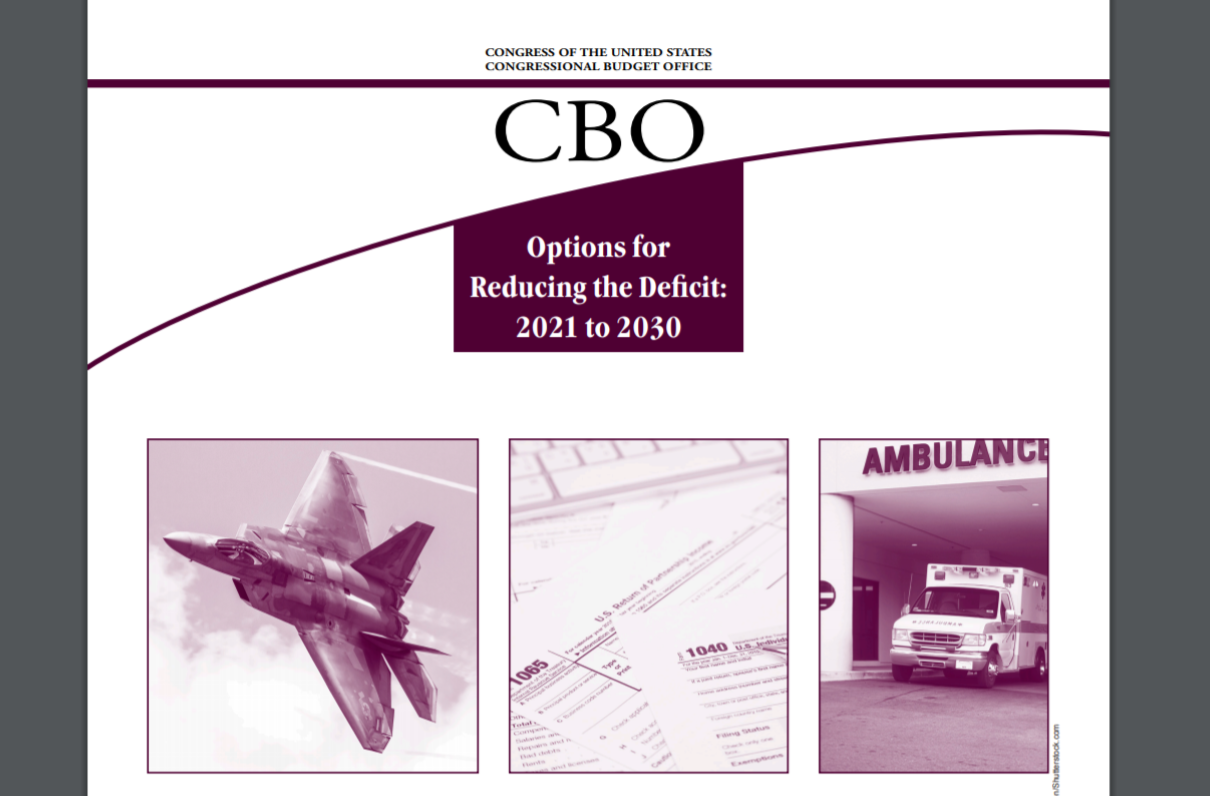Every two years, just before a new Congress is sworn in, the Congressional Budget Office (CBO) releases a report offering ways the incoming legislators could tackle the nation’s growing budget deficit. But while this year’s version calculates potential savings over five- and 10-year windows from 2021 to 2030, it does little to nothing to calculate what these options would mean for the bottom line of those in the crosshairs.
When it comes to servicemembers, retirees, and veterans, MOAA attempts to fill in those gaps.
The CBO’s deficit-cutting proposals are consistent over the years, even predictable. But the current fiscal climate, combined with uncertainties highlighted by a pandemic nearing its first year, are far from normal and nowhere near predictable. While many government agencies are not fans of these options — several may seem too extreme — the harsh reality of our national debt, combined with a $3.3 trillion deficit, may redefine tolerance for the measures offered by the CBO. And it is worth noting the CBO provides these options with no recommendations as to their use.
[RELATED: More Advocacy News From MOAA]
The list includes options to reduce mandatory and discretionary spending, along with plans to increase federal revenue. Of the 83 options, MOAA identified 13 you should know – items that, if enacted, could cost retirees, veterans, or those now in uniform quite a bit, all in the name of finding solutions to reduce our national deficit.
Here’s the focused list by category:
Mandatory Spending
- Introduce Enrollment Fees Under TRICARE for Life
- Increase Premiums for Parts B and D of Medicare (Part B key to MOAA’s interests)
- Raise the Full Retirement Age for Social Security
- End VA’s Individual Unemployability Payments to Disabled Veterans at the Full Retirement Age for Social Security
- Reduce VA’s Disability Benefits to Veterans Who Are Older Than the Full Retirement Age for Social Security
- Narrow Eligibility for VA’s Disability Compensation by Excluding Veterans With Low Disability Ratings (30% and lower)
- Use an Alternative Measure of Inflation to Index Social Security and Other Mandatory Programs (what’s know as “chained CPI” – a move that would change the cost-of-living adjustment calculation for retired pay)
Discretionary Spending
- Reduce the Department of Defense’s Budget
- Cap Increases in Basic Pay for Military Service Members (Employment Cost Index, or ECI, minus 0.5%)
- Reduce the Basic Allowance for Housing to 80 Percent of Average Housing Costs
- Reduce the Annual Across-the-Board Adjustment for Federal Civilian Employees’ Pay
Revenues
- Include Disability Payments From the Department of Veterans Affairs in Taxable Income
- Increase the Payroll Tax Rate for Social Security
Below, we go in-depth on two options that directly impact those currently serving. Stay tuned to The MOAA Newsletter (check your delivery settings) and MOAA.org for updates.
Capping Pay Increases
This proposed option caps basic pay raises for all eight of our uniformed services at 0.5% below the ECI starting in January 2022 and continuing through 2027. Note that the current pay raise slated for the FY 2022 National Defense Authorization Act (NDAA), which would effect pay starting Jan. 1, 2022, sits at 2.7%.
Let’s look at what this option would mean for an E-7 with 16 years in service on January 2022, assuming she makes E-8 in January 2024 and retires on Jan. 1, 2028:
- For her last six years in uniform, she loses $6,840. But it gets worse.
- Because of those losses, she’ll start out $1,700 behind in her first year of retirement pay (as calculated by the average of her last 36 months, or High-3).
- Assuming an average ECI at 2.5% (then subtracting 0.5%, per the CBO proposal) and a 2.5% COLA, she’d lose a total of $44,000 over the next 20 years.
Reducing BAH
The proposal to reduce the Basic Allowance for Housing (BAH) to 80% of average housing costs would increase the out-of-pocket share paid by uniformed servicemembers by 15 percentage points (DoD covers 95% now, a figure that had been at 99% before other recent changes).
The reductions would take place over nine years, with 1.7 percentage points knocked off each year. It sounds minor, but at the end, here are two examples of the impact on our servicemembers:
- For a Marine E-7 with kids stationed in San Diego, the $3,165 monthly benefit becomes $2,665, a loss of $6,000 per year.
- For an Army O-5 with kids serving at the Pentagon, the $3,144 monthly benefit becomes $2,647, a loss of $5,964 per year.
This benefit cut is more than just financial: Servicemembers seeking to live within their new financial means will find smaller houses in worse neighborhoods with longer commutes. This lower quality of life would lead to a lower retention rate.
For more on previous attempts to overhaul BAH with negative impacts to servicemembers, check out this MOAA video from 2017:
Going Beyond the Numbers
These two examples -- pay caps and BAH reductions -- bring the CBO’s options to the kitchen table, where our servicemembers and their families will discuss the impact to them and their quality of life … and likely their thoughts on whether to stay in the service or build their future elsewhere. Stay tuned for deeper analysis on other report items.
MOAA will not stand idly by while the new Congress gets read in on these options. It will be up to us to engage them here on the Hill, and for our members – either individually or through our councils and chapters – to engage them back home. Future analyses will be accompanied with calls to action as soon as the 117th Congress is sworn in and the furniture and boxes are out of the hallways.
MOAA Knows Why You Serve
We understand the needs and concerns of military families – and we’re here to help you meet life’s challenges along the way. Join MOAA now and get the support you need.



